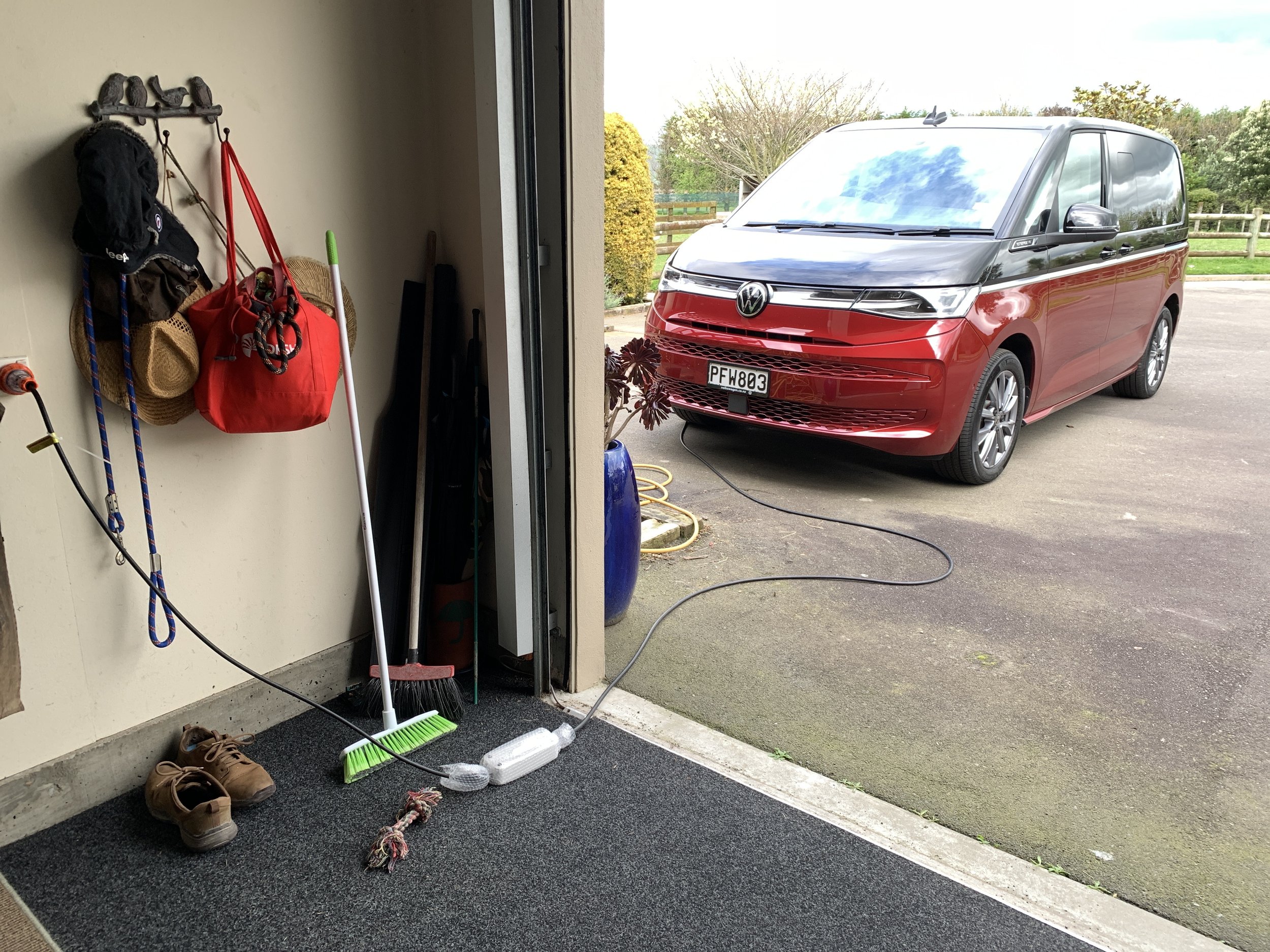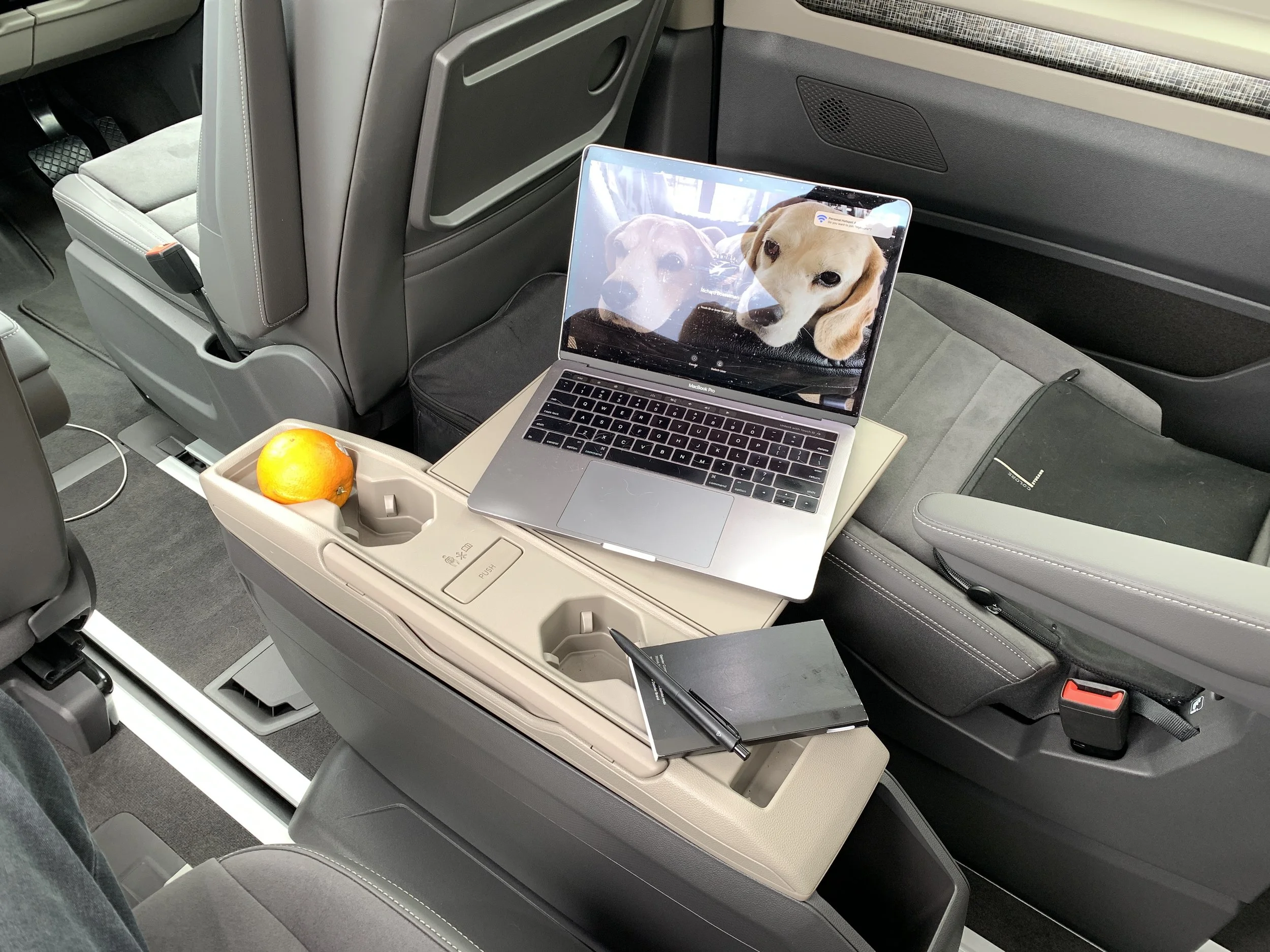VW Multivan PHEV roadtest review: One out of the box
/It’s a clever and comfy experience, but the price of the best seats will make you sit down.
Price: $106,800
Engine: 1395cc inline four-cylinder petrol with single electric motor and 13kWh battery, 160kW/350Nm combined out (110kW/250Nm engine alone), six-speed dual clutch automatic, combined optimal economy 1.7 litres per 100km, CO2 37g/km.
Vital statistics: 4973mm long, 1941mm wide, 1907mm high, 3220mm wheelbase, 469 litres luggage capacity, 18-inch alloy wheels.
We like: Sharp looker, savvy technology, richly appointed.
Not so much: Richly priced, slow to recharge.
ALL sorts of pleasant surprises cropped up when spending a week with this vehicle, from how many charger ports it has for phones and laptops to the sheer comfort and driveability just seeming so un-van-like … for a van.
Sure, the latter sentiment is stating the obvious, if you know the back story to this latest Volkwagen Multivan.
But, thing is, if you don’t and instead happen to judge this vehicle simply by how it presents in the glass and metal then … well, you’ll call it out for what it is. But kinda really isn’t.
Because? Until now, the Multivan was a derivative of the Transporter commercial vehicle, which included panels cans, crew cabs and the California camper van.
That multi-purpose remit meant some compromise in each instance. Even the passenger versions, no matter how upmarket, struggled to quite match the refinement you’d get from a passenger car. Arguably the styling didn't interest private, non-business buyers and, even though VW vans have always presented strongly with credible gear, they probably pondered if the safety elements were on par, too.
All of which triggered Volkswagen into completely re-thinking the product into what it has become now. Still obviously a van, but just in look. This new T7 now sits on the MQB platform that underpins VW Group cars, a shift that allows all sorts of improvements and optimisations, most of which make it more car-like in its feel, specification provision and performance. Interestingly, though, it also makes it a better van.
When initial planning began in 2015, one of the most important factors was that it was smaller than the Transporter to make it less demanding to park. So the roof height is a bit lower. Despite this, there is more interior height because the MQB platform has a lower floor level. So if you’re a van fan, that’s a big plus.
Anyway, the more important alteration is that the new architecture also enabled Volkswagen Commercial Vehicles to create its first plug-in hybrid.
Hence why it’s been fast-tracked into New Zealand, into two – Family and Energetic - trim formats, both with a common drivetrain. There’s clearly an emergent Kiwi taste for having vehicles that involve electrical impetus.
Volkswagen here will leverage this all the more with next year’s ID.Buzz, but having for now a seven-seater that can at least deliver some battery-fed driving now is a big step moment in itself.
While non-electrified powertrains are offered overseas, and the plug-in will be joined by a diesel-dedicated variant next year, having this PHEV model here right now is a powerful statement.
What you’re buying is effectively the same powertrain Skoda has been using in its Octavia and Superb; a 110kW 1.4-litre four-cylinder petrol engine and an 85kW electric motor, fed by a 13kWh lithium-ion battery pack, with a six-speed DSG dual clutch transmission sending the power to the front wheels.
You’re likely thinking ‘that sounds a bit puny’, given the VW’s size, but it’s not too bad. The basics are that the combined maximum output of 160kW and 350Nm are valid and, though the pure electric side might seem limited in its battery-fed range, the whole set-up is much more meritorious.
While it’s well known that plug-in hybrids hardly ever deliver their claimed fuel economy unless, presumably, one runs on zero emissions for 90 percent of the time, the VW worked hard to prove itself, to a point where it seemed better in this setting than in the Skodas.
The potential for fuel saving comes at no small cost, more’s the pity. You’d struggle to call the Family conveniently priced. The Energetic on test, being $27,200 dearer, is nowhere close.
Sure, when involving electric and, also, when buying into a semi-premium brand, there’s always a degree of ‘premium’ going on. Yet, while it is beautifully-presented and very nice to live with, a six-figure price is hard to swallow. It’s pretty patent why just 30 examples of the flagship are here.
If the spend can be managed, then you’re buying a nice setting. The Family is robustly sorted, and a sensible choice, but if you want to impress, the Energetic is the one to have.
It adds a lot of finishing touches - a power tailgate, tri-zone climate control, ‘ArtVelours’ upholstery, heated front seats with power adjustment and a massage function. It also completes the driver assist suite by adding in park assist, rear cross traffic alert and side assist with blind spot monitoring, all of which genuinely useful with a vehicle of this size and shape. Another beneficial addition is adaptive cruise control, which was great on a 340km open road drive, and a new swerve support and oncoming vehicle braking system.
It also looks a lot more stylish, with two-tone paint, LED Matrix headlights, a front light strip across the grille, the panoramic glass roof, 30-colour interior ambient lighting, the hands-free opening for the side doors and tailgate. The 18-inch wheels suit it far better. All that stuff, plus the cabin’s comfort and obvious air of quality, impressed the heck out of friends I chauffeured to dinner one evening.
One thing about buying a box; you get lots of room. Another core appeal of any passenger-based van, too, is the optimisation of access. Sliding side doors might speak to commercial convenience, but they’re far better in tighter parking spaces than conventional hinged doors.
Slip in and you’re entering an apartment. Multivan has seven seats, all adult-sized, offering adult-desired head and legroom. Being individual items is a bonus; though complete removal can be a faff, they’re all light enough. The passenger section can be configured in different ways, including having the second-row chairs facing backward; unfortunately not for driving as, unlike in a Transporter, the belts cannot be anchored safely.
However, as far as I know the Multivan stands out from anything else by having electrified rails on the floor. In addition to sliding and positioning the seats, these can also be heated without the need to do any plugging-in or connecting of power. That’s smart.
The elevated driving position is total van-man, but visibility is good as, along with it having a very large windscreen, a split A-pillar adds more glass to reduce the potential for blind spots. Looking at the back and rear three-quarter is not easy; that’s why it has cameras and offering a high-resolution picture on the 10-inch touchscreen.
Multivan is automatic only. VW’s push to provide a flat floor in the ront and enough space to walk through to the rear means the handbrake and the gear selector are on the dash; the latter looks like a big light switch, so that might take newbies a moment to fathom.
The driving experience is smooth and far more polished. It has a lovely settled feel on the road, even crosswinds don’t perturb it. Build quality is very good – no rattles here – and Volkswagen has gone to great lengths to make it a more enjoyable vehicle to steer, with much work having gone into the suspension design in a bid to provide the ride comfort traditional car buyers would expect.
The 13kWh battery (10.4kWh net) is theoretically capable of 42 kilometres of electric-only driving, but perhaps NZ electricity runs differently to Europe’s, because after one replenishment it displayed a 44km capacity. Suits me.
It always begins its journey using electric power so long as there is some charge and speeds of up to 140kmh are possible using only the electric motor, after which the combustion engine automatically activates.
Prioritising electric works very effectively for short stint, urban pace driving. You can go on short trips with little need to bother the engine; a day spent in this regime saw it return an average of 1.9 litres per 100km. Incredible and very close to the factory optimal.
If you’re going further afield, though, or running at 100kmh for any period of time, then brace yourself for Big Oil’s invariable involvement. How much of that depends on your driving style and how you utilise the system. To keep fuel burn in check, it’s most logical to switch to a setting to increase energy recovery, instigating a sort of one-pedal driving feel.
This set-up has some good tricks. For one, you can also reserve a set level of charge in the battery if it needs to be kept for a zero-emission segment of the journey. Also, even when the battery depletes, it doesn’t really exhaust completely to ‘zero’. Realistically, exhausted still means there’s about 20 percent energy left.
That might seem oxymoronic, but it protects the battery and also means there’s enough always in reserve to allow it to continue in a hybrid mode that alternates between the combustion engine and the electric motor; with some surprisingly decent returns.
Notwithstanding the early thrift, the overall consumption from almost 500kms’ running was 6.5 litres per 100km, but I’m sure that would have been lower had I put effort into keeping the battery charged during the final three days.
It’s not that hard, because the battery port is sensibly located (on the driver's side front wing) and VW provides a home recharging kit with a decently long cable, but end-of-day running asked for a full overnight replenishment – a process the household financial controller became increasingly less keen about as the week wore on. I could have put it onto a commercial charger, but it’s only AC replenishment, so even then you’re there for a while. An update to DC replenishment and a much larger battery would do it the world of good, but perhaps cost would also rise.
The big drive started with a full battery and initially the returns were almost as good as I’d seen in the city. By the halfway point, consumption was starting to creep up and when the battery was little more than dead weight, the engine had to work harder still. Even so, at the end of the drive the average was just 4.2L/100km. As said, what proved ruinous thereafter was me not bothering to charge it up overnight; it’s a bit of a drag and takes a while, but that’s what you need to do to keep in the Green zone.
Two points worth making. One, I wasn’t putting any effort into economy driving styles. Though it offers no outright sporting pretension, neither does it feel underpowered and I drove it at normal pace. If anything, the Multivan felt more energetic in the step off (yes, I’m aware it’s a bad pun) and more linear in its urban and open road performance than the Skoda Superb I drove with this very same powerplant.
Power levels are adequate with the electric motor alone, and it’s smooth and quiet then, but the petrol engine can be hushed so long as it isn't being put under too much strain. Put your foot to the floor and the two working together produce 162kW, but things get noisy when you do that.
The second point, which demands consideration given the type of vehicle it is, is that most of my driving was solus. I accept that’s not likely to be truly representative of a real life experience, but couldn’t be avoided. I’d fully expect that having a full accompaniment of passengers on board would have to hurt performance and the battery range.
Multivan’s delivery with plug-in hybrid tech is a plus point, but it’s hard to argue how it lends a unique advantage in this Energetic guise.
The flagship’s awkward price position likely puts it out of reach of those who need it most and also leaves it disadvantaged against a decent crop of sports utilities that, while not as spacious, have the same seat count and often deliver with the added plus of all-wheel-drive. But into a Volvo XC90 and you’ll get all that, plus similar plushness and, yes, also petrol-electric.
A shame, because the vast interior space and the quality of its design shine through. The PHEV drivetrain has benefits, too, not least for those with shorter journeys to undertake.
























